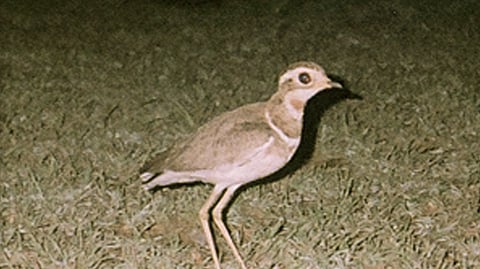

VISHAKHAPATNAM: One small bird, long unseen, led to the declaration of a wildlife sanctuary, years of research, and a sustained conservation effort. The Jerdon’s Courser, once thought to be extinct, was rediscovered in the YSR Kadapa district of Andhra Pradesh in 1986 after nearly a century, and that rediscovery continues to inspire fresh hope and dedicated fieldwork even today.
The Jerdon’s Courser is a restricted-range endemic bird found only in the Eastern Ghats of Andhra Pradesh. Designated Critically Endangered on the IUCN Red List, it inhabits sparse scrub forests with open patches of ground and is currently known only from the Sri Lankamalleswara and Sri Penusila Narasimha wildlife sanctuaries.
Nearly two decades have passed since the last confirmed sighting in 2004 in the Sri Lankamalleswara wildlife sanctuary. Yet, the Andhra Pradesh Forest department believes the critically endangered bird may still be hiding in the scrub forests of Kadapa, and efforts to trace it have intensified in recent months.
Kadapa district forest officer Vineet Kumar explained that the department has deployed nearly 40 camera traps in the sanctuary, especially across the foothill regions of Siddavatam, Badvel, and Proddatur forest ranges. “These traps are equipped with both motion and infrared sensors to capture images of the nocturnal species. Along with that, we use sand strips to track bird footprints and place dung to attract insects, which may, in turn, attract the bird,” he said.
Jerdon’s Courser (Rhinoptilus bitorquatus), first recorded by British surgeon Dr Thomas C Jerdon in 1848, was presumed extinct through much of the 20th century. Its dramatic rediscovery in 1986 near Reddipalli village prompted the creation of the Sri Lankamalleswara wildlife sanctuary in 1998. Despite its elusive nature, the rediscovery proved the species still existed and sparked long-term conservation efforts.
“Recently, we started using two audio moth devices to record bird calls during the night. These sound recorders are helping us monitor vocal activity in the area,” Vineet Kumar said. However, that audio confirmations remain challenging as some local birds are known to mimic the Courser’s call, he admits.
A team of over 20 regular forest staff, supported by outsourcing personnel and local residents, is actively involved in tracking, maintaining monitoring devices, and protecting the bird’s habitat. “Apart from the department’s daily efforts, NGOs and wildlife experts have been working for several years to trace the bird through surveys, data collection, and awareness campaigns,” he said.
The bird is known for its preference for scrub forest habitats with vegetation such as Carissa species (locally known as Kalivi Chettu). “In Telugu, the bird is called Kalivikodi, ‘Kodi’ meaning bird and ‘Kalivi’ referring to the shrub it is often found near,” Vineet Kumar explains. “It camouflages well in these thorny bushes, making sightings rare,” he points out.
Its nocturnal habits and limited scientific understanding of the bird’s behaviour, nesting patterns, and movements add to the challenges of tracing. “There have been no confirmed sightings after 2004, though there were some claims in 2008 and 2009. Some people have reported hearing its call, but these have not been verified,” he says.
Apart from the Lankamalleswara sanctuary, another important site under observation is the Sri Penusila Narasimha wildlife sanctuary, which lies across the Sagileru river. Both areas are part of the known historic habitat of the bird, which includes stretches along the Penna river in Kadapa, Anantapur, and Nellore districts, and the Godavari valley near Sironcha and Bhadrachalam.
“A key challenge is raising awareness among local communities while also ensuring their livelihood needs are met, so that pressure on the scrub forest is reduced,” Vineet Kumar explains, adding, “With growing awareness and the department’s round-the-clock commitment, we believe the habitat remains secure, which strengthens our hope.”
Despite the challenges, the department remains hopeful. “We believe the habitat is still suitable. The scrubland and thorny vegetation remain intact, and that gives us reason to continue our efforts. Like in 1986, we believe that patience, consistency, and scientific monitoring may once again lead us to this rare bird,” he says.
As a symbol of hope, its image was featured on a postal stamp in 1988.